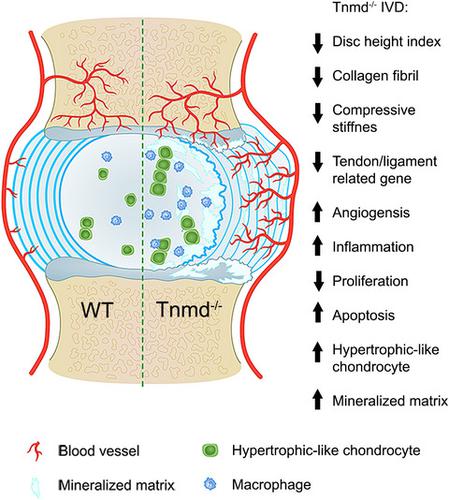当前位置:
X-MOL 学术
›
Aging Cell
›
论文详情
Our official English website, www.x-mol.net, welcomes your feedback! (Note: you will need to create a separate account there.)
Loss of tenomodulin expression is a risk factor for age-related intervertebral disc degeneration.
Aging Cell ( IF 7.8 ) Pub Date : 2020-02-21 , DOI: 10.1111/acel.13091 Dasheng Lin 1, 2 , Paolo Alberton 1 , Manuel Delgado Caceres 3 , Carina Prein 4 , Hauke Clausen-Schaumann 4 , Jian Dong 5 , Attila Aszodi 1 , Chisa Shukunami 6 , James C Iatridis 7 , Denitsa Docheva 3
Aging Cell ( IF 7.8 ) Pub Date : 2020-02-21 , DOI: 10.1111/acel.13091 Dasheng Lin 1, 2 , Paolo Alberton 1 , Manuel Delgado Caceres 3 , Carina Prein 4 , Hauke Clausen-Schaumann 4 , Jian Dong 5 , Attila Aszodi 1 , Chisa Shukunami 6 , James C Iatridis 7 , Denitsa Docheva 3
Affiliation

|
The intervertebral disc (IVD) degeneration is thought to be closely related to ingrowth of new blood vessels. However, the impact of anti‐angiogenic factors in the maintenance of IVD avascularity remains unknown. Tenomodulin (Tnmd) is a tendon/ligament‐specific marker and anti‐angiogenic factor with abundant expression in the IVD. It is still unclear whether Tnmd contributes to the maintenance of IVD homeostasis, acting to inhibit vascular ingrowth into this normally avascular tissue. Herein, we investigated whether IVD degeneration could be induced spontaneously by the absence of Tnmd. Our results showed that Tnmd was expressed in an age‐dependent manner primarily in the outer annulus fibrous (OAF) and it was downregulated at 6 months of age corresponding to the early IVD degeneration stage in mice. Tnmd knockout (Tnmd−/−) mice exhibited more rapid progression of age‐related IVD degeneration. These signs include smaller collagen fibril diameter, markedly lower compressive stiffness, reduced multiple IVD‐ and tendon/ligament‐related gene expression, induced angiogenesis, and macrophage infiltration in OAF, as well as more hypertrophic‐like chondrocytes in the nucleus pulposus. In addition, Tnmd and chondromodulin I (Chm1, the only homologous gene to Tnmd) double knockout (Tnmd−/−Chm1−/−) mice displayed not only accelerated IVD degeneration, but also ectopic bone formation of IVD. Lastly, the absence of Tnmd in OAF‐derived cells promoted p65 and matrix metalloproteinases upregulation, and increased migratory capacity of human umbilical vein endothelial cells. In sum, our data provide clear evidences that Tnmd acts as an angiogenic inhibitor in the IVD homeostasis and protects against age‐related IVD degeneration. Targeting Tnmd may represent a novel therapeutic strategy for attenuating age‐related IVD degeneration.
中文翻译:

Tenomodulin表达的丧失是与年龄相关的椎间盘退变的危险因素。
椎间盘退变(IVD)被认为与新血管的向内生长密切相关。但是,抗血管生成因子在维持IVD血栓形成方面的影响仍然未知。Tenomodulin(Tnmd)是肌腱/韧带特异性标志物和抗血管生成因子,在IVD中表达丰富。尚不清楚Tnmd是否有助于维持IVD稳态,从而抑制血管向该正常无血管组织的向内生长。在这里,我们调查是否可以通过缺乏Tnmd自发地诱发IVD变性。我们的结果表明,Tnmd主要以年龄相关的方式在外环纤维(OAF)中表达,并且在6个月大时被下调,与小鼠的IVD退化早期相对应。Tnmd基因敲除(Tnmd - / -)小鼠表现出与年龄有关的IVD变性更快的进展。这些迹象包括胶原纤维直径较小,抗压刚度明显降低,与IVD和肌腱/韧带相关的多个基因表达降低,诱导的血管生成和OAF中的巨噬细胞浸润以及髓核中的肥大样软骨细胞。此外,TNMD和软骨调节I(Chm1,唯一的同源基因TNMD)双敲除(Tnmd - / - Chm1 - / -)小鼠不仅显示了加速的IVD变性,而且还显示了IVD的异位骨形成。最后,在OAF衍生的细胞中Tnmd的缺失促进了p65和基质金属蛋白酶的上调,并增加了人脐静脉内皮细胞的迁移能力。总而言之,我们的数据提供了明确的证据,表明Tnmd在IVD稳态中起血管生成抑制剂的作用,并能防止与年龄有关的IVD变性。靶向Tnmd可能代表减轻与年龄有关的IVD变性的新型治疗策略。
更新日期:2020-02-21
中文翻译:

Tenomodulin表达的丧失是与年龄相关的椎间盘退变的危险因素。
椎间盘退变(IVD)被认为与新血管的向内生长密切相关。但是,抗血管生成因子在维持IVD血栓形成方面的影响仍然未知。Tenomodulin(Tnmd)是肌腱/韧带特异性标志物和抗血管生成因子,在IVD中表达丰富。尚不清楚Tnmd是否有助于维持IVD稳态,从而抑制血管向该正常无血管组织的向内生长。在这里,我们调查是否可以通过缺乏Tnmd自发地诱发IVD变性。我们的结果表明,Tnmd主要以年龄相关的方式在外环纤维(OAF)中表达,并且在6个月大时被下调,与小鼠的IVD退化早期相对应。Tnmd基因敲除(Tnmd - / -)小鼠表现出与年龄有关的IVD变性更快的进展。这些迹象包括胶原纤维直径较小,抗压刚度明显降低,与IVD和肌腱/韧带相关的多个基因表达降低,诱导的血管生成和OAF中的巨噬细胞浸润以及髓核中的肥大样软骨细胞。此外,TNMD和软骨调节I(Chm1,唯一的同源基因TNMD)双敲除(Tnmd - / - Chm1 - / -)小鼠不仅显示了加速的IVD变性,而且还显示了IVD的异位骨形成。最后,在OAF衍生的细胞中Tnmd的缺失促进了p65和基质金属蛋白酶的上调,并增加了人脐静脉内皮细胞的迁移能力。总而言之,我们的数据提供了明确的证据,表明Tnmd在IVD稳态中起血管生成抑制剂的作用,并能防止与年龄有关的IVD变性。靶向Tnmd可能代表减轻与年龄有关的IVD变性的新型治疗策略。



























 京公网安备 11010802027423号
京公网安备 11010802027423号